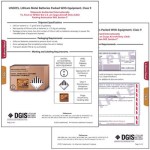The U.S. Department of Transportation’s new final ruling on the safe transport of lithium batteries was published today in the Federal Register. The adopted amendments in the final rule pertain to 49 CFR, Parts 171, 172, 173, and 175. Read the full text here.
According to the agency, PHMSA’s new standards (HM-224F) will “strengthen safety conditions for the shipment of lithium cells and batteries. These changes, some of which focus specifically on shipments by air, will better ensure that lithium cells and batteries are able to withstand normal transportation conditions and are packaged to reduce the possibility of damage that could lead to an unsafe situation.” View the full PHMSA press release here
 Check out Labelmaster’s Lithium Battery Advisor software, which includes instructions, required packaging and labeling, and more!
Check out Labelmaster’s Lithium Battery Advisor software, which includes instructions, required packaging and labeling, and more!
This final rule amends hazard communication and packaging provisions for the safe transport of lithium batteries. The promulgation of this final rule will bring into line the Hazardous Materials Regulations (HMR) with applicable provisions of the United Nations (UN) Model Regulations, the International Civil Aviation Organization’s Technical Instructions for the Safe Transport of Dangerous Goods by Air (ICAO Technical Instructions) and the International Maritime Dangerous Goods (IMDG) Code. According to PHSMA, the effective date will start six months from the date the rule is published in the Federal Register (UPDATE: PHMSA announced an extension to the mandatory compliance date, which is now August 7, 2015 for non-air transport of lithium cells and batteries).

See Labelmaster’s line of IMDG publications, including the current IMDG Code, Multimodal Combo Package, IMDG Software and IMDG Training!
Based on an initial analysis of the final rule, it is expected that this amendment will:
- Enhance packaging and hazard communication requirements for lithium batteries transported by air;
- Replace “equivalent lithium content” with “Watt-hours” for lithium ion cells and batteries; (note: although not interchangeable terms, both figures offer a measurement of the power (or size) of a lithium ion cell or battery)
- Adopt separate shipping descriptions for lithium metal batteries and lithium ion batteries;
- Revise provisions for the transport of small and medium lithium cells and batteries including cells and batteries packed with, or contained in, equipment;
- Revise the requirements for the transport of lithium batteries for disposal or recycling;
- Harmonize the provisions for the transport of low production and prototype lithium cells and batteries with the ICAO Technical Instructions and the International Maritime Dangerous Goods Code; and
- Adopt new provisions for the transport of damaged, defective, and recalled lithium batteries.
The HMR currently authorizes shipments of lithium batteries transported to and from the U.S. to conform to either the ICAO Technical Instructions by air or the IMDG Code by vessel. Although the HMR permits the use of these shipping descriptions (see 74 Federal Register 2207 August 25, 2009), these shipping description entries have not appeared in the Hazardous Materials Table § 172.101. The end result of this regulatory inconsistency equates to the potential for frustrated shipments and confusion among shippers in the regulated community. Moreover, comments taken during NPRM development stage mirrored these sentiments and stated that “differences between U.S. and international requirements for lithium batteries detract from safety by creating confusion and excessively complicating the detailed set of regulations that already apply to lithium battery shipments.”
Need to transport Lithium Batteries? We have your labeling solution!
At present, the Hazardous Materials Table (HMT) in § 172.101 contains three entries for lithium batteries. (1) Lithium battery (UN3090), (2) Lithium batteries, contained in equipment (UN3091), and (3) Lithium batteries packed with equipment (UN3091). Separate entries for these have existed in the IMDG code and ICAO since 2009 and PHMSA allows their use domestically via ground before or after being transported by air.
The table shown below compares the current U.S. DOT lithium battery shipping descriptions to the international lithium battery shipping descriptons (ICAO and IMDG). (Soure: 74 Federal Register 2207 August 25, 2009):
In this final rule, PHMSA is adopting the new HMT entries shown in the table below (Source: 79 Federal Register 46012 August 06, 2014):
Overall, PHMSA claims that the outcome of this new ruling will improve safety by way of risk reduction. Such improvements noted by U.S. DOT include:
- the added use of reliable packaging
- hazard communication
- inspection and acceptance checks before loading cargo aboard aircraft
- pilot notification
- training of employees
The final rule carries an effective date of August 6, 2014 with voluntary compliance starting immediately. Mandatory compliance begins February 6 of 2015 unless otherwise noted in the amendment.







Pingback: PHMSA Announces Mandatory Compliance Date Extension to HM-224F for Non-Air Transport of Lithium Batteries | Labelmaster Blog